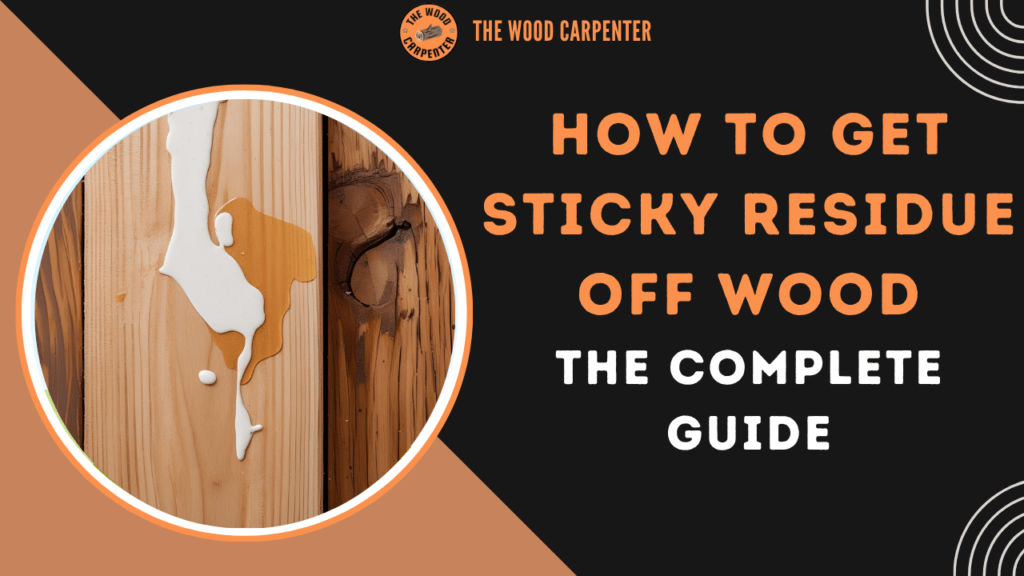
It can be really annoying to see sticky stuff on wood surfaces, such tape, stickers, spilled liquids, or old adhesive labels. With the correct tools and a little time, you can bring back the natural beauty of your wood without hurting the finish.
This complete tutorial will show you how to safely and successfully get sticky residue off of wood, step by step. It will also answer the most common questions concerning sticky messes on wood.
Why Does Sticky Residue Stick to Wood ?
Sticky residue clings to wood for several reasons:
Porous Surface: Wood has natural pores that can absorb adhesives, which makes them difficult to get off.
Finish Type: Finished wood is less likely to absorb sticky substances, while unfinished wood can soak them up.
Type of Residue: Some adhesives are formulated to be extra strong, making removal more challenging.
Understanding the nature of the residue and your wood’s finish is the first step to choosing the best removal method.
Step-by-Step Guide: How to Remove Sticky Residue from Wood
1. Assess the Situation
Identify the residue: Is it fresh or hardened? Is the wood finished or unfinished?
Test your method: Always start with the gentlest approach.
2. Start with Gentle Cleaning
Warm Soapy Water
- Mix a few drops of mild dish soap with the warm water.
- Dampen a microfiber cloth (not soaking wet) and gently rub the sticky area.
- Wipe away any loosened residue and also dry with a clean cloth.
Heat Method
- Use a hairdryer on low heat, holding it 3-5 inches from the surface.
- Move the dryer in circles for 30 seconds to soften the adhesive.
- Wipe away the softened residue with a cloth.
3. Try Natural Solutions
Vinegar Solution
- Mix equal parts white vinegar and water.
- Dampen a cloth with solution and gently rub the sticky spot.
- For unfinished wood, use vinegar sparingly to avoid damaging the surface.
Olive Oil or Vegetable Oil
- Apply a small amount of oil to the residue and let it soak for 10-30 minutes.
- Gently rub with a cloth or plastic scraper.
- Wipe away the excess oil with a clean, damp cloth.
Mayonnaise or Peanut Butter
- Spread a thin layer on the residue and let it sit for 15-30 minutes.
- The oils help break down adhesives.
- Wipe clean with a soft cloth.
4. Use Stronger Methods for Stubborn Residue
Rubbing Alcohol
- Dab isopropyl alcohol onto a cotton ball or cloth.
- Gently rub the sticky area—do not pour alcohol directly on the wood.
- Wipe clean with a damp cloth.
Nail Polish Remover (Acetone)
- Only for unfinished or unvarnished wood.
- Apply a small amount to a cotton ball and then rub gently.
- Wipe with a damp cloth and dry thoroughly.
Commercial Adhesive Removers
- Use products specifically labeled safe for wood.
- Follow the manufacturer’s instructions carefully.
Also read:
Oil-Based Stain vs Water-Based Stain: Which One Should You Choose ?
Water Stains on Wood: 6 Step-by-Step Tricks to remove it
5. Scrape Carefully (If Needed)
- Use a plastic scraper or old credit card to lift stubborn residue.
- Avoid metal tools to prevent scratching the wood.
6. Finish and Protect
- Once residue is removed, clean the area again with soapy water.
- Dry thoroughly.
- For finished wood, apply furniture polish or a wood conditioner to restore shine and protection.
Tips for Different Types of Wood
| Wood Type | Best Method | Caution |
| Finished Wood | Soapy water, vinegar, rubbing alcohol | Avoid harsh chemicals |
| Unfinished Wood | Vinegar (sparingly), oil, acetone | Test first, avoid soaking |
| Antique Wood | Oil, gentle scraping | Consult a professional |
Pro Tips to Prevent Damage
- Always work gently and avoid excessive moisture.
- Never use abrasive pads or harsh chemicals unless you’re certain they’re safe for your wood type.
- Test every cleaning solution in hidden spot first.
- Act quickly—fresh residue is easier to remove than old, hardened gunk.
Frequently Asked Questions (FAQ)
1. What is the safest way to remove sticky residue from wood?
The safest method is to start with the warm soapy water and a soft cloth. If that doesn’t work, move on to natural oils or vinegar, always testing first.
2. Can I use rubbing alcohol on wood?
Yes, but use it sparingly and then apply it to a cloth, not directly to the wood. It’s effective for dissolving adhesive but can dry out or dull some finishes if overused.
3. Will vinegar damage wood?
Vinegar is generally safe for finished wood when diluted with water. For unfinished wood, use it with caution and test first, as it can affect the wood’s appearance.
4. What should I avoid when cleaning sticky residue off wood?
Avoid abrasive scrubbing pads, metal tools, and harsh chemicals not labeled safe for wood. These can scratch, discolor or it might strip the finish.
5. How do I remove sticker residue from antique or delicate wood?
Use the gentlest method possible, such as olive oil or a soft cloth. If in doubt, consult a furniture restoration professional to avoid damaging valuable pieces.
6. Can I use commercial adhesive removers on wood?
Yes, but only if they’re specifically labeled as safe for wood. Always follow the manufacturer’s directions and test in an inconspicuous area first.
7. Is it possible to restore the shine after removing sticky residue?
Absolutely! After cleaning, use a wood polish or conditioner to restore luster and protect the surface from future damage.
Final thoughts
It doesn’t have to be hard to get sticky stuff off of wood. You may safely bring back the beauty of your wood by starting with soft, natural remedies and only moving on to stronger methods if you need to.
Always test the method you choose first, work slowly, and finish with a protective shine to keep your wood looking its best.

